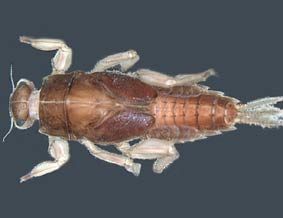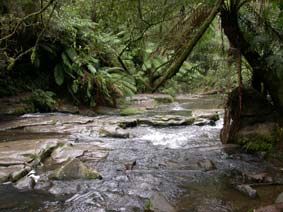Major Group: Insecta
Order: Ephemeroptera
Family: Teloganodidae (formerly Ephemerellidae)
Genus: Austremerella (Ephemerellina)
Species: picta
This family is represented in Australia by a single species, Austremerella picta . |
Descriptive Features: nymph robust, heavily sclerotized
head with pair of small dorsal protuberances
antennae slender, length less than width of head capsule
mandibles well developeds, heavily sclerotized
pronotum subrectangular, narrowing slightly to anterior, corners somewhat angular
tarsal claws with 4-5 ventral teeth
abdomen broad, dorsoventrally flattened
abdominal segments 1- 10 each with a pair of strong backwardly directed dorsal spines near posterior margin
abdominal segments 2-9 with posterolateral spines
gills present on abdominal segments 2-6
each gill with upper lamella oval, plate-like, and lower lamella divided into 2 branches, each branch bearing a linear series of small overlapping lobes
Total length: up to 10 mm |

|
Austremerella picta |
|
|
|
Taxonomic Checklist:
Austremerella picta Riek |
|
Distribution: SE Qld, NE NSW
Sensitivity Rating: SIGNAL grade 9
Functional Feeding Group: shredders |

|
Erskine River, Vic |
|
|
Ecology: Instream habitat: Austremerella picta can be locally common in coastal streams over a wide altitudinal range (60-900m), but appears to be restricted to riffle zones of streams in native forested areas. Nymphs are found on leaf packs over pebbles and cobbles. They do not occur in areas where silt cover is apparent.
Feeding ecology: Nymphs are shredders feeding on leaves and wood.
Habit:
Life history: In the northern hemisphere, females lay their eggs in a group on the water surface, allowing the movement of the water to disperse them widely. The eggs may hatch immediately or after various lengths of development that ranges from one week to 10-11 months. |
| |
Information Sources: Dean & Suter 1996, Chessman & Boulton 1999, Peters & Campbell 1991, Riek 1963, Williams & Feltmate 1992 |
|
|
|